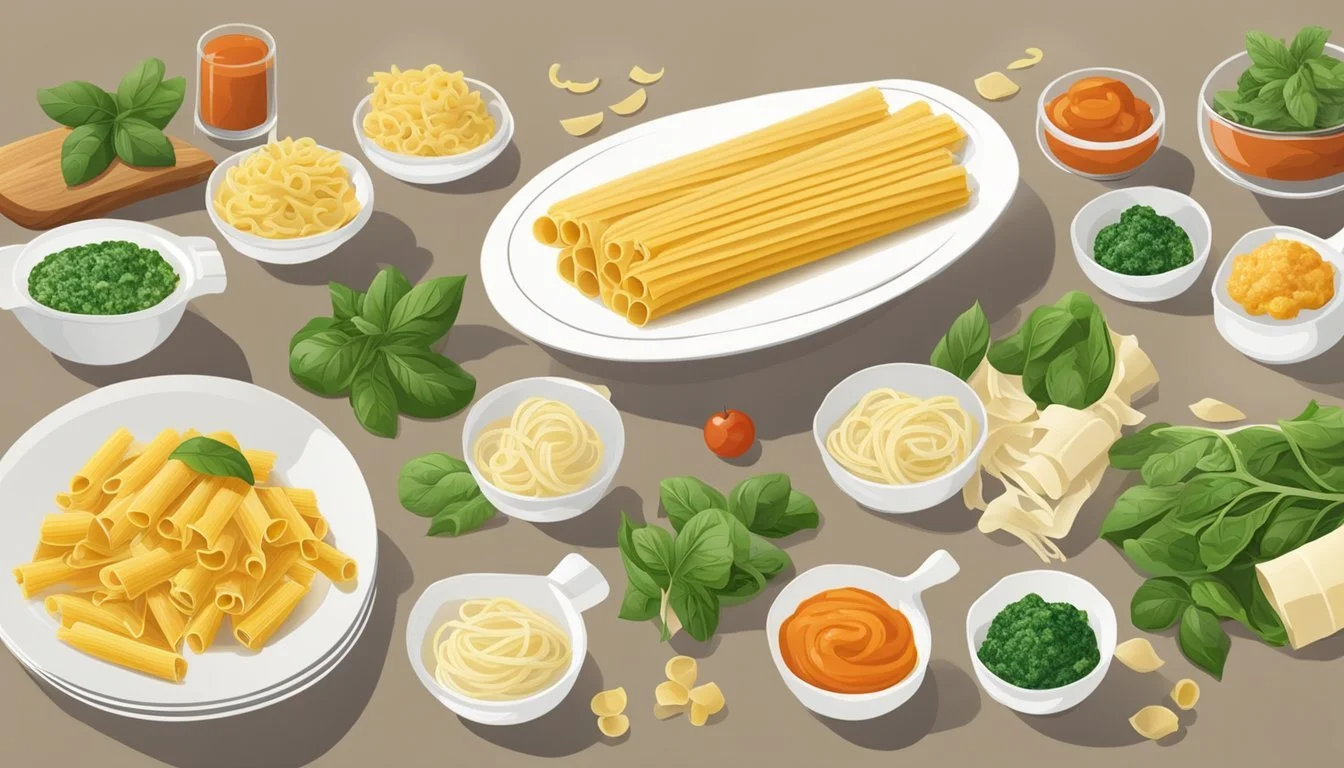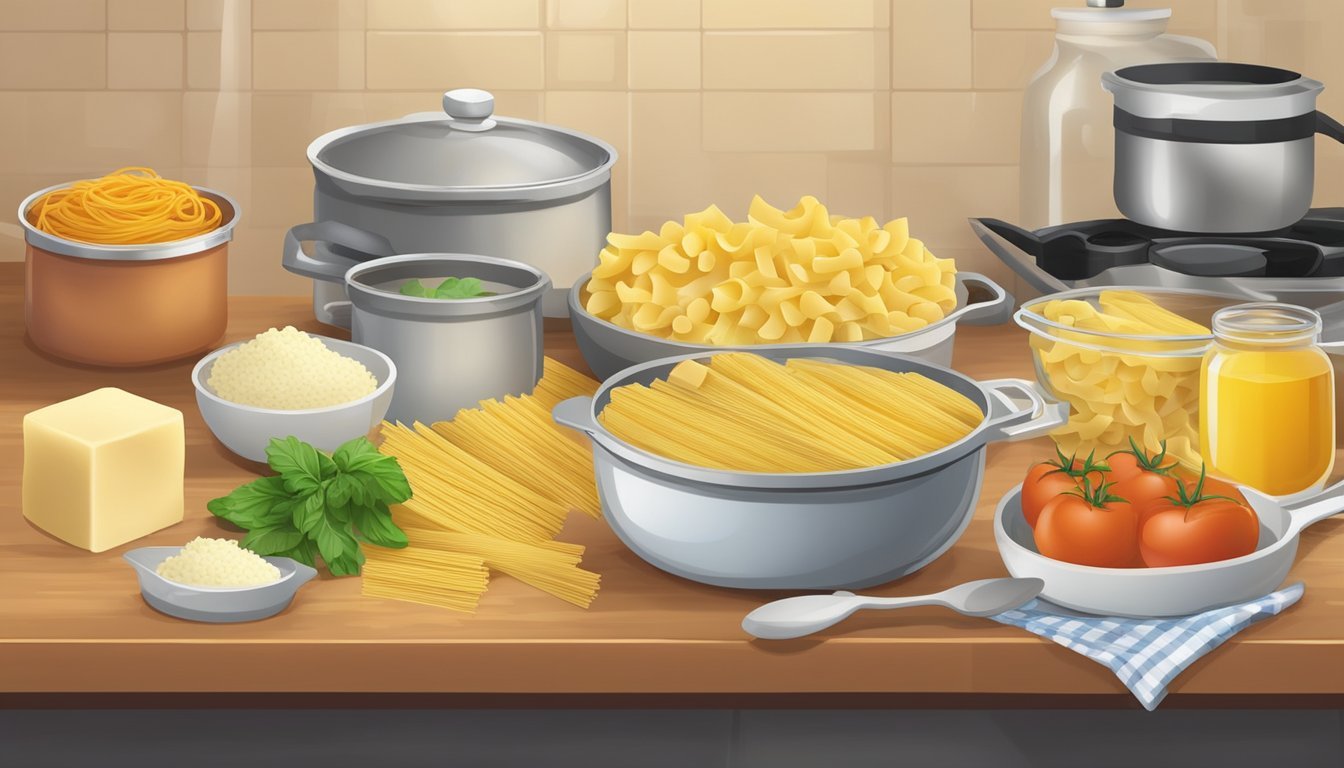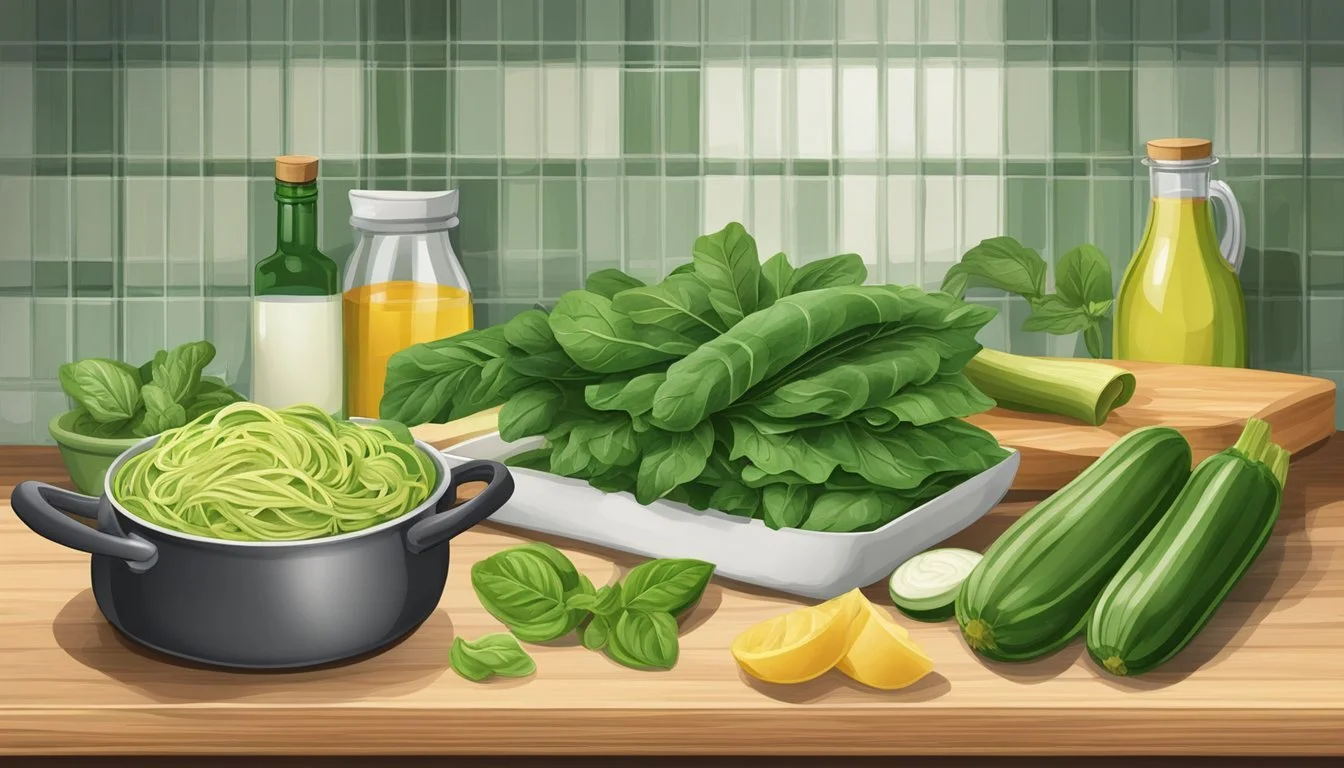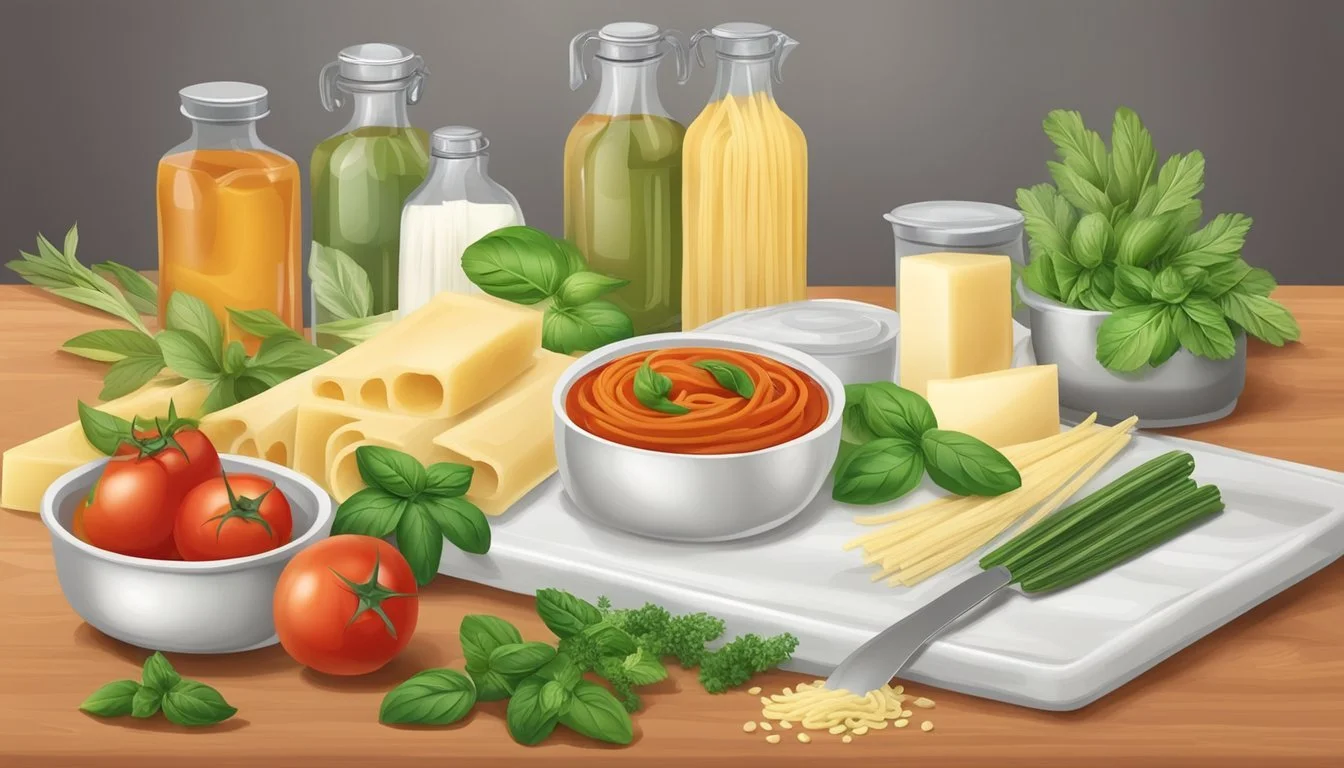Cannelloni Pasta Substitutes
Top Alternatives for Your Italian Dishes
Cannelloni pasta, a staple in Italian cuisine, is renowned for its ability to be generously stuffed with a variety of fillings, ranging from rich cheeses to hearty meats. It is also commonly known as manicotti in the United States. The name cannelloni translates to 'large reeds', aptly describing their tubular shape which lends itself to a satisfying bite and an excellent vessel for savory sauces and fillings. Dating back to the early 1900s, this pasta (What wine goes well with pasta?) variety has become a classic in both home cooking and upscale dining.
While cannelloni offers a unique culinary experience, there are scenarios where substitutes may be necessary. Dietary restrictions, ingredient availability, or simply a desire for variety can prompt the search for alternatives. Pasta substitutes like rice noodles and brown rice pasta provide gluten-free options, while innovations such as kelp noodles and shirataki noodles offer low-carb alternatives without compromising on texture or taste.
When selecting a substitute for cannelloni, it is important to consider the end goal of the dish. Factors such as the ability to hold fillings, maintain structure during cooking, and compatibility with the accompanying sauces and flavors are crucial. Each substitute brings its own qualities and merits to a dish, enabling home cooks and professional chefs alike to explore new culinary territories while respecting dietary needs and personal preferences.
Characteristics of Cannelloni
Cannelloni are a testament to the creativity of Italian cuisine, exhibiting unique features that set them apart as a pasta variety. They are distinguished by their tubular shape and are traditionally served baked, often creating a centerpiece in Italian dining.
Defining Cannelloni
Cannelloni refers to large pasta tubes that measure approximately one inch in diameter. Their structure allows for a variety of fillings to be encapsulated within. The tubes are made from a rectangle of pasta, rolled with a generous portion of filling into a cylindrical shape. Their design is particularly intended for holding stuffings such as cheese, meat, vegetables, or a mixture of these ingredients.
Importance in Italian Cuisine
In Italian cuisine, cannelloni is celebrated for its hearty and comforting nature. It is an essential dish, especially for festive occasions and family gatherings. They necessitate oven-baking, which allows the flavors of the cannelloni and its fillings to meld beautifully. When baked, the exterior becomes slightly crisp, while the interior containing the stuffing remains rich and succulent. This dish eloquently captures the essence of Italian culinary traditions—the love for food that brings people together.
Ingredients and Preparation
When crafting cannelloni, selecting quality ingredients and following a meticulous preparation process are crucial to the success of the dish. Here we examine the components and methods that underpin classic cannelloni creation, ensuring an exceptional result.
Traditional Ingredients
The foundation of cannelloni revolves around pasta sheets, which can either be pre-made or homemade using a simple combination of flour, eggs, and a pinch of salt. For the filling, ricotta and spinach are traditional choices, providing a creamy texture and fresh flavor. Incorporating garlic adds a subtle pungency, while seasoning with more salt strengthens the tasteful impact of the other ingredients.
A harmonious blend for the filling often integrates cheeses such as ricotta or mozzarella, and meat such as ground beef or a meat substitute for those preferring plant-based versions can be included. Cannelloni is bathed in sauce, commonly a rich tomato sauce or a bechamel, to infuse the dish with moisture and robust taste.
Ingredient Traditional Use Substitutes (If any) Pasta Sheets Cannelloni Shells Lasagna Sheets, Crepes Ricotta Filling Cream Cheese, Tofu (Vegan) Spinach Filling Kale, Swiss Chard Ground Meat Filling (meat variant) Lentils, Meat-Free Mince (Vegan) Tomato Sauce Topping Before Baking Bechamel, Pesto Cheese Enhance Filling or Sprinkled on Top Dairy-Free Cheese (Vegan)
The Preparation Process
The preparation of cannelloni begins with sautéing garlic in olive oil until fragrant. This is often the first step for creating a base flavor for both the filling and the sauce. The filling is then prepared by combining cheese like rich ricotta, spinach, and additional elements as desired, seasoned precisely with salt and pepper for taste.
For assembly, the filling is piped or spooned into uncooked cannelloni tubes or alternatives like lasagna sheets, rolled to form tubes. Once filled, the pasta is placed into a baking dish prepped with a layer of sauce to prevent sticking.
Finally, the dish is coated with more sauce, allowing the flavors to meld during baking. It is typically cooked in an oven preheated to a temperature range between 160°C to 200°C (320°F to 392°F), depending on the specific recipe, until the pasta is tender and the top is slightly golden. A final brush with olive oil can ensure a desirable crispness to the surface.
Cannelloni Substitutes
When choosing substitutes for cannelloni, cooks should consider the structure of the pasta as it is essential for stuffing and ensuring the fillings are well-contained. Below are suitable alternative pasta types, and gluten-free and vegan options, to mimic the traditional cannelloni experience.
Alternative Pasta Types
Manicotti stands as a prominent choice due to its tube-like shape, allowing for generous fillings of cheese and meats. With a structure similar to cannelloni, it supports an equivalent preparation method.
Lasagna Sheets can be modified for a cannelloni-like dish. One would simply roll the sheets with fillings inside to create individual pasta rolls, mimicking the traditional cannelloni tubes.
Another substitute, Ziti, is a good option when sliced lengthwise and stuffed, although it's notably smaller in diameter.
Gluten-Free and Vegan Options
For those with dietary restrictions such as gluten intolerance, selecting a gluten-free pasta made from rice or corn flour may offer a suitable alternative. Such pastas maintain structural integrity similar to traditional wheat pasta when cooked properly.
The search for an appropriate vegan cannelloni substitute often leads to the use of vegetables. Thinly sliced zucchini or eggplant, when rolled with fillings, can serve as an excellent gluten-free and vegan-friendly cannelloni replacement.
Vegan fillings can leverage vegan cheese alternatives, which blend well with spinach and other plant-based ingredients, offering a delicious and compassionate cannelloni filling.
Cannelloni Cooking Techniques
Cannelloni cooking techniques involve precise steps to ensure this pasta dish comes out perfectly baked with a sumptuous filling. Mastery of these methods allows for a melt-in-your-mouth experience with cannelloni retaining its structure while delivering layered flavors.
Baking Cannelloni
Baking is the canonical way to finish cannelloni, transforming it into a comfort dish with a golden-brown top layer. To begin, one often stuffs uncooked cannelloni with a filling of choice, such as ricotta and spinach. It is advisable to use a baking dish that accommodates the cannelloni in a single layer to promote even cooking. Prior to filling the pasta, preheating the oven to a standard temperature — commonly between 350°F (175°C) to 400°F (200°C) — is essential for a consistent cook time.
Layer the base of the baking dish with sauce (tomato or béchamel) to prevent sticking and add flavor.
Fill the pasta tubes using a piping bag or a makeshift one from a plastic bag with a corner snipped off.
Cover the filled pasta with more sauce and, if desired, a sprinkle of cheese.
Bake until the sauce is bubbly and the top is golden, typically for about 30 minutes to 45 minutes.
The cannelloni should emerge from the oven with a crispy edge, the pasta cooked through but not overly soft, giving a desirable slight bite or what Italians call "al dente".
Boiling Pasta
Boiling pasta is a fundamental skill in pasta preparation but is not always required for cannelloni. If one is using "oven-ready" cannelloni tubes, boiling can be omitted. However, if traditional cannelloni pasta is opted for, it should be boiled al dente before stuffing.
Here are the steps for properly boiling cannelloni pasta:
Fill a large pot with water and bring to a rolling boil.
Add a pinch of salt and the cannelloni tubes.
Stir gently to separate the pasta and prevent sticking.
Refer to the pasta's packaging for the precise cook time, but typically aim for 7-8 minutes or until al dente.
Drain the pasta and allow it to cool slightly before filling.
This pre-cooking step ensures that the pasta is perfectly tender once baked, without becoming too soft and losing its satisfying texture.
Customizing Cannelloni Recipes
Cannelloni offers a versatile canvas for culinary creativity, allowing for numerous adaptations of fillings and sauce pairings tailored to various dietary preferences, including vegetarian and meat-based diets.
Filling Variations
Cannelloni fillings can range from the traditional spinach and ricotta to innovative meat-free alternatives. A vegetarian staple, spinach and ricotta, remains a classic choice, blending leafy greens with creamy dairy to create a satisfying stuffing. To tailor the recipe to non-dairy diets, one can substitute ricotta with alternatives like cashew or almond-based "cheeses".
For a meatier texture without the use of animal products, meat-free mince offers a substantial filling that pairs well with a variety of herbs and spices. To achieve the desired consistency and flavor, cooking the mince until it changes color indicates it's well-seasoned and ready for stuffing.
Classic: Spinach and ricotta, seasoned with nutmeg and salt
Meat-Free Mince: Browned with onions, garlic, and herbs for depth of flavor
Sauce Pairings
When it comes to sauces, marinara sauce made with ripe tomatoes serves as a foundation for cannelloni, offering a tangy and robust complement to both vegetarian and meat fillings. Cannelloni dishes can be enhanced with a variety of tomato-based sauces or enriched with cream-based alternatives for a richer finish.
Marinara Sauce: A simple blend of tomatoes, garlic, and basil
Creamy Tomato Sauce: Enriched with dairy or nut-based cream
Béchamel: A white sauce option for those seeking a creamier texture without tomato
By mixing and matching fillings and sauces, one can create an array of cannelloni recipes, each with unique taste profiles catered to different preferences and dietary requirements.
Serving and Presentation
When presenting cannelloni, the key lies in complementing the rich pasta with appropriate garnishes and well-chosen side dishes. This enhances both the visual appeal and the balance of the meal.
Garnishes and Toppings
Garnishing cannelloni involves a sprinkle of fresh parsley, which adds a pop of color and an herbal note without overpowering the dish. A light dusting of grated Parmesan or a drizzle of olive oil can elevate the presentation as well as enrich the flavor profile.
Side Dishes
A well-chosen side dish should contrast yet harmonize with the creamy and dense texture of cannelloni. Here is a list of vegetables and sides that can accompany the pasta:
Vegetables: Steamed or roasted vegetables like asparagus, zucchini, or bell peppers provide a nutritious and colorful addition to the plate.
Salad: A simple Caprese salad, dressed with balsamic, can offer a refreshing contrast.
Rating Side Dish Comment 4.5 Roasted Vegetables "Adds a delightful crunch and earthy taste." 4.7 Caprese Salad "The freshness complements the rich pasta."
Choosing sides with a rating of 4.5 or higher ensures that they are generally well-received with cannelloni.
Storage and Leftovers
Proper storage maximizes the flavor and texture of cannelloni leftovers, ensuring delicious meals even days later. Using quality containers and the right techniques, one can enjoy cannelloni at its best.
Storing Cooked Cannelloni
After enjoying a hearty meal of cannelloni, it's important to store leftovers quickly to maintain freshness. The cannelloni should be cooled to room temperature within two hours of cooking to prevent bacterial growth. Once cooled, leftovers can be placed in an airtight container. A drizzle of olive oil can help prevent the pasta from sticking together. If topped or filled with cheese, ensure it's spread evenly to avoid clumps. Leftovers should be consumed within:
Refrigerator: 3-5 days
Freezer: Up to 2 months
Note: When freezing, consider adding a layer of cling film beneath the container lid to reduce freezer burn.
Reheating Tips
Reheating cannelloni preserves its integrity when done correctly. For best results, they recommend:
Oven: Preheat to 350°F (175°C). Cover cannelloni with aluminum foil to prevent drying out. Heat for 20-30 minutes, or until thoroughly warm.
Microwave: Use a microwave-safe dish and cover with a damp paper towel. Heat on medium power in 90-second intervals, checking the temperature between intervals.
When reheating frozen cannelloni, it's best to thaw it overnight in the refrigerator before reheating. Quick reheats can lead to uneven heating, with the cheese potentially not melting properly.









